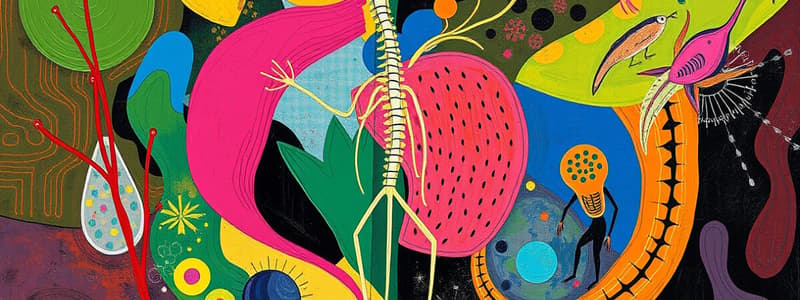Podcast
Questions and Answers
Which of the following are requirements to define a living thing? (Select all that apply)
Which of the following are requirements to define a living thing? (Select all that apply)
- Ecosystem
- Organization (correct)
- Community
- Metabolism (correct)
- Homeostasis (correct)
What is the definition of homeostasis?
What is the definition of homeostasis?
Regulation of internal temperature despite changes in environmental temperature.
The two subclasses of metabolism are ______ and ______.
The two subclasses of metabolism are ______ and ______.
Anabolism, Catabolism
What are the two types of reproduction?
What are the two types of reproduction?
Define response as it relates to defining living things.
Define response as it relates to defining living things.
What are the steps in the scientific method?
What are the steps in the scientific method?
What is another name for glucose?
What is another name for glucose?
Where does the glucose chain break to change to its cyclical form?
Where does the glucose chain break to change to its cyclical form?
What is a saccharide?
What is a saccharide?
Starches are examples of what?
Starches are examples of what?
Flashcards are hidden until you start studying
Study Notes
Requirements to Define a Living Thing
- Seven fundamental criteria: Organization, Metabolism, Homeostasis, Growth, Reproduction, Response, and Evolution.
- Definitions may vary, but this list serves as a useful guideline.
Homeostasis
- Refers to the regulation of internal temperature regardless of external environmental changes.
Metabolism
- Comprises two main processes:
- Anabolism: The creation of larger cellular structures from smaller units.
- Catabolism: The breakdown of larger cell structures into smaller components.
- Represents the totality of an organism's chemical reactions.
Types of Reproduction
- Asexual reproduction: Involves a single organism dividing itself to create offspring.
- Sexual reproduction: Requires the fusion of sperm and egg cells, resulting in a complete genetic set for a new organism.
Response to Stimuli
- Reflects an organism's ability to respond to environmental stimuli, known as irritability.
- Examples include withdrawing a hand from heat or a plant bending towards sunlight.
Scientific Method Steps
- Observations lead to questions.
- A testable hypothesis is formed.
- Predictions based on this hypothesis are made.
- Predictions are tested through experimentation.
- Results inform new hypotheses and predictions, creating an iterative process.
Glucose
- Also known as dextrose, a fundamental carbohydrate.
Glucose Structure
- The glucose chain transitions to its cyclic form at the oxygen in the aldehyde functional group.
Saccharides
- Defined as sweet substances, commonly understood as simple sugars and monomers.
Starches
- Recognized as examples of polysaccharides, which are complex carbohydrates made from many sugar units.
Studying That Suits You
Use AI to generate personalized quizzes and flashcards to suit your learning preferences.




